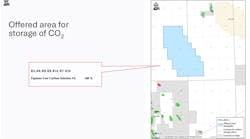Gene Kliewer • Houston
OBS surveys set
Two ocean bottom seismic survey projects are on tap for Reservoir Exploration Technology. In Norway, RXT has a $21-million letter of intent for a three-month survey to begin in 3Q 2008. RXT says Vestland Marine’sVikland is being modified as a combined source and cable handling vessel.
Meanwhile, RXT reports its largest ever ocean bottom cable seismic contract. A $210-million contract will provide Petrobras with two years of both 4C and 2C OBS data covering several producing fields in Campos basin. This work also is scheduled to start in the second half of 2008.
Busy off Australia
A great deal of seismic activity is reported for offshore Australia. Bass Strait Oil Co. Ltd. has started a 250-km (155-mi) 2D seismic survey in east Gippsland basin permit VIC/P41. One specific target of the survey is Lead A in the southeastern part of the permit which was identified in a 2003 2D survey. The current survey meets BSO’s third-year commitment for VIC/P41.
CGGVeritas’Pacific Titan moved into the area following a 1,192-km (741-mi) survey in Bass basin at Targa. That work meets BSO’s commitment for T/42P and T/43P.
Data from the survey will be processed and interpreted to create and more detailed subsurface map of the Durroon sub-basin. The new Targa 2D data will be integrated with existing geological and geophysical data.
BSO operates VIC/P41 with 45% interest. Partners Moby Oil & Gas Ltd. and Eagle Bay Resources NL will retain 25% and 17.5%, respectively, once a 12.5% farm-out to Oil Basins Ltd. is complete.
MEO Australia Ltd. had the PGS Australia acquisition vesselM/V Orient Explorer at work in NT/P68 to get 380 sq km (147 sq mi) of 3D data over its Blackwood discovery and also part of the Blackwood East structure.
Norway work
Bergen Oilfield Services AS has won a contract from Aker Exploration for 3D work in the Norwegian Sea. Scheduled to begin in 3Q 2008, the 300-sq km (116-sq mi) project will use the six-streamerBOS Arctic.
PGS sets record
Petroleum Geo-Services reports a new record during a project in the Norwegian North Sea. TheRamform Sovereign deployed 17 streamers towed 50 m (164 ft) apart as part of a high-density 4D project.
Another such record looms.
“We are extremely happy with the performance of the vessel during the first weeks of operation,” says Vidar Hovland, president, Marine Acquisition, PGS. “We are confident that we will achieve new towing records later this year whenRamform Sovereign starts on the industry’s largest ever HD4D job for Petrobras where parts of the job will be conducted with 18 streamers at 50 m separation.”
Petrobras awarded the $251-million high density 4D seismic survey to PGS. The 4,945 sq km (1,909 sq mi), five-survey program is scheduled to begin in Campos, Santos, and Espirito Santo basins off Brazil in October 2008
The high-density time-lapse surveys program will use an 18-streamer x 8,000 m x 50 m spread or 14-streamer x 8,000 m x 50 m spread, depending upon Petrobras imaging requirements.
New technology
Landmark has added Panasas parallel storage clusters to its technological portfolio because “conventional storage can’t keep pace with the parallel processing functions required for most seismic processing jobs.”
The Panasas product is designed to allow geoseismic data processing without bottlenecks or downtime, Landmark says.
E&P companies consistently acquire huge volumes of new seismic data and also re-analyze existing data. This often means processing terabyte-level data files. As a result, they are becoming increasingly reliant on their High-Performance Computing (HPC) infrastructures, especially for high input/output jobs.
Often, processing hardware waits while storage systems strain to catch up – creating a textbook input/output bottleneck. Panasas ActiveStor parallel storage clusters, which include the company’s PanFS parallel file system, eliminate these bottlenecks to improve application performance, linear scalability, and higher overall utilization of compute clusters, Panasas says.
Landmark says its seismic processing R&D group is optimizing its software to take advantage of the new storage system.
Schlumberger has introduced its new Carbonate Advisor petrophysics and productivity analysis service. Carbonate Advisor offers a systematic analytical framework to efficiently evaluate the petrophysics of carbonate rocks. The system integrates data from magnetic resonance, elemental capture spectroscopy, logs, and core data to produce a single formation evaluation of carbonate reservoirs, Schlumberger says.
In field tests in a wide variety of carbonate reservoirs, relative permeability and water saturation measurements from Carbonate Advisor matched discrete core analysis data. These continuous measurements permitted a more accurate prediction of fluid flow leading to better production performance.
Mergers and acquisitions
TGS-Nopec Geophyscial Co. has acquired “substantially all” of the assets of Center Line Data Corp. for $5 million. Center Line provides well log digitizing software and services.
“The Center Line transaction represents a strategic acquisition for our Geologic Products division,” said Rod Starr, senior VP of TGS Geological Products & Services. “Center Line has developed proprietary well log digitizing software that will allow TGS to greatly accelerate the creation of LAS files from our comprehensive well log image inventory.”
Sercel, the manufacturing subsidiary of CGGVeritas, has acquired Metrolog, a supplier of gauges and downhole instruments.
Headquartered in Toulouse, France, Met-rolog makes high temperature/high pressure gauges and other downhole measurement equipment.
“Metrolog developed a unique expertise over the past 20 years, through continuous R&D, for high quality, versatile, and reliable downhole instrumentation for challenging well conditions,” says Pascal Rouiller, president and CEO of Sercel.
Sierra Leone seismic processing under way
Elixir Petroleum Ltd. is processing data acquired in a 3D seismic program offshore Sierra Leone. The program covered 1,222 sq km (472 sq mi) on block SL-4. Processing is expected to be complete by year end. Elixir says it will then interpret the data in 1Q 2009. “As recently appointed operator of block SL-4, we are delighted that the first in-field activities have been successfully completed on time and on budget,” says Andrew Ross, Elixir MD. “The newly acquired 3D data will allow us to better refine the play types and very large targets previously identified from the existing high quality 2D seismic data set.” Elixir holds 35% interest in SL-4. Water depths on the block range from 100 m to 3,500 m (328 ft to 11,482 ft) over 4,429 sq km (1,710 sq mi).
null




